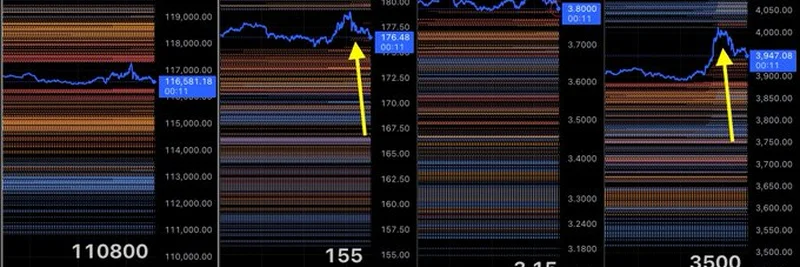If you’ve been keeping an eye on the crypto market lately, you might have noticed some wild price swings in Bitcoin, Solana, and Ethereum. A recent tweet from MartyParty (@martypartymusic) on August 8, 2025, sheds light on what could be happening behind the scenes. The post suggests that these price pullbacks aren’t just random market moves—they might be tied to intentional actions by Binance, one of the biggest crypto exchanges, using its market maker, Wintermute. Let’s break it down in a way that’s easy to digest, even if you’re new to the crypto world.
What’s Happening in the Tweet?
MartyParty shared some eye-catching charts showing price drops in Bitcoin ($BTC), Solana ($SOL), and Ethereum ($ETH) around the same time. The charts, marked with yellow arrows, highlight a sharp decline that aligns with on-chain data—transactions recorded on the blockchain. According to the tweet, this data points to Binance moving 7,000 $ETH and 69,752 $SOL to Wintermute, a major market-making firm, within just three hours. This move, MartyParty argues, is a deliberate attempt to manipulate prices and trigger liquidations—where traders get forced out of their positions due to margin calls.
The idea here is that Binance, by shifting large amounts of crypto to Wintermute, could be influencing the market to drop prices. This tactic might help them profit by liquidating leveraged traders—those who borrow money to amplify their trades—when prices fall below certain levels. The on-chain evidence, which is publicly verifiable on the blockchain, backs up this claim, making it a hot topic among crypto enthusiasts.
What Is Market Manipulation, Anyway?
For those unfamiliar, market manipulation is when someone artificially influences an asset’s price to gain an advantage. In traditional finance, this might involve spreading fake news to pump up a stock. In crypto, it can look like large players moving big chunks of coins to create panic or profit opportunities. The Binance-Wintermute connection suggests a coordinated effort, where the exchange uses its market maker to control liquidity and price action. This isn’t a new concept—crypto markets, being less regulated than traditional ones, are sometimes prone to such moves, especially on exchanges with high trading volumes.
Why Does On-Chain Data Matter?
On-chain data is like a public ledger of every crypto transaction. Unlike off-chain data (which happens outside the blockchain), on-chain transactions are transparent and can’t be hidden. When MartyParty points to Binance sending $ETH and $SOL to Wintermute, anyone can check the blockchain to confirm it. This transparency is a double-edged sword—it exposes potential manipulation but also gives traders a tool to spot these moves. The charts in the tweet show how prices dipped right after these transfers, hinting at a pattern worth watching.
What This Means for Crypto Traders
If this analysis holds water, it’s a wake-up call for anyone trading on Binance or similar platforms. Leveraged trading, while tempting for big gains, can backfire if exchanges manipulate prices to trigger liquidations. The tweet’s comments section is buzzing with frustration—some users call it a “scam,” while others question its legality. For newbies, this might feel discouraging, but it’s also a chance to learn. Watching on-chain data and avoiding over-leveraged positions can help you navigate these choppy waters.
Is This Legal?
The big question on everyone’s mind is whether this is allowed. Crypto regulation is still a gray area, especially in the U.S., where no single law governs it fully. Agencies like the Commodity Futures Trading Commission (CFTC) treat some cryptocurrencies as commodities, but enforcement is patchy. Market manipulation is illegal in traditional markets, but in crypto, the lack of clear rules leaves room for debate. MartyParty’s post doesn’t claim legal action but urges awareness, leaving it to regulators and the community to figure out the next steps.
What Can You Do?
So, what’s a trader to do with this info? First, keep an eye on on-chain analytics tools like Etherscan or Solscan to track big moves yourself. Second, consider diversifying your trades across multiple platforms to reduce reliance on one exchange. And if you’re into meme tokens or other speculative assets (which we cover a lot at Meme Insider), be extra cautious during these volatile periods. Some are even debating whether to “buy the dip” or wait it out—decisions, decisions!
The Bigger Picture
This incident highlights a key challenge in crypto: the balance between innovation and regulation. As blockchain tech grows, so does the need for oversight to protect traders. For now, on-chain data is your best friend for spotting trends and staying informed. Whether Binance’s actions are a strategic play or something more nefarious, the crypto community is watching closely. Stay tuned to Meme Insider for more updates on how this unfolds and how it might affect the meme token space and beyond!
Got thoughts on this? Drop them in the comments—we’d love to hear your take!



